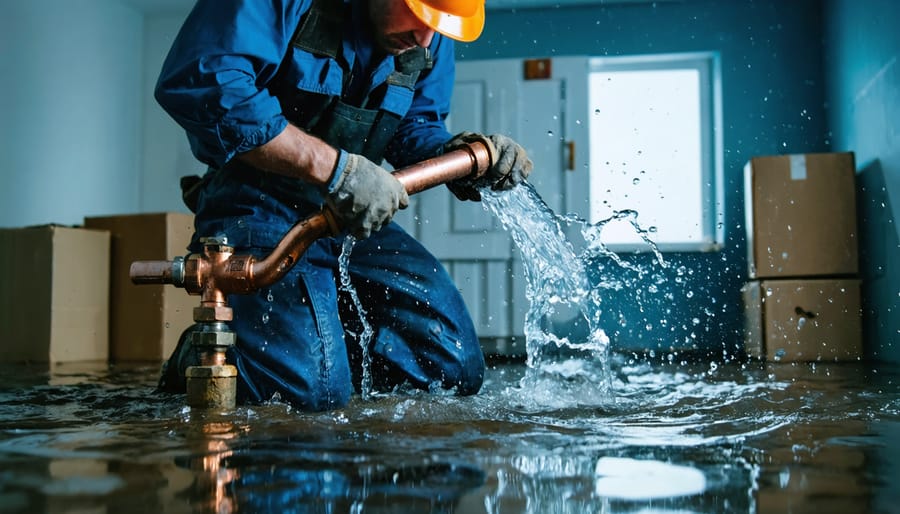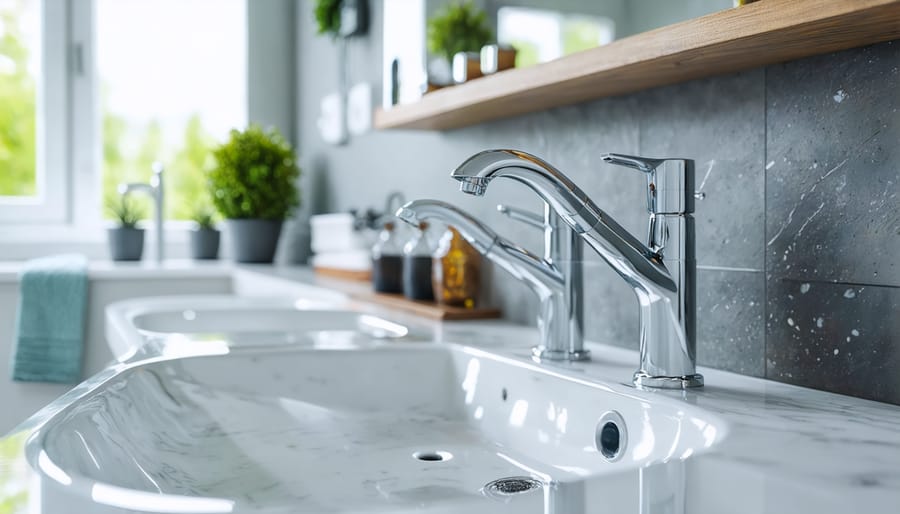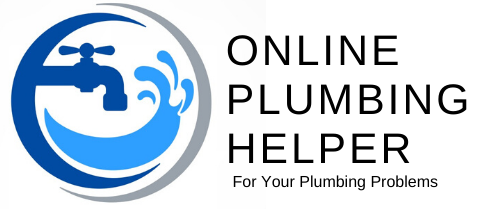
Assess your plumbing emergency’s severity first—a burst pipe flooding your basement demands immediate action, while a slow drain can wait. When water damage threatens your home’s foundation or electrical systems, speed matters more than finding the perfect financing solution.
Consider live AI matching services that connect you with multiple payday lenders simultaneously, potentially securing funds within hours rather than days. These platforms compare offers instantly, helping you identify the lowest APR available for your situation—crucial when every percentage point adds up during financial stress.
Request quotes from at least three plumbers before committing to any loan amount. Emergency plumbing costs vary wildly, from $150 for a simple fix to $5,000 for major repairs. Borrowing exactly what you need prevents overextending yourself with unnecessary debt.
Here’s what Sarah from Milwaukee learned: “My water heater burst at 2 AM, and I panicked into taking the first loan offer—22% interest on $3,000. The plumber actually fixed it for $800. I paid $500 in interest for money I didn’t even need.”
Plumbing emergencies intersect with your home’s entire infrastructure—electrical systems, structural integrity, and even your insurance coverage. Understanding these connections helps you make smarter borrowing decisions. While payday loans offer quick relief, they carry significant costs that demand careful consideration, especially when alternatives might exist even in urgent situations.
Why Plumbing Emergencies Can’t Wait (And Why They’re So Expensive)

The Real Cost of Emergency Plumbing
Understanding the actual costs you’re facing can help you make smarter decisions about emergency funding. Let’s break down what typical plumbing emergencies really cost.
Minor fixes like faucet and sink repairs typically run between $150-$350, while toilet repairs usually cost $200-$400 depending on the issue. These repairs, though inconvenient, are often manageable without major borrowing.
Mid-range emergencies get pricier. A burst pipe repair averages $500-$1,000, depending on accessibility and damage extent. Water heater repairs range from $300-$600 for fixes, while full replacements can reach $1,500-$3,000.
Major plumbing disasters like sewer line replacements ($3,000-$10,000) or extensive leak damage represent the upper end of emergency costs. Sarah from Ontario shared her experience: “When our main line backed up, the $4,500 bill felt overwhelming, but knowing the exact cost helped us explore targeted financing options instead of panicking.”
Remember, these figures typically include labor, materials, and emergency service fees (which can add 50-100% to regular rates). Many plumbers offer free estimates even during emergencies, so you’ll know exactly what you’re facing before committing to any loan. This transparency lets you borrow only what you truly need, avoiding unnecessary debt while addressing your urgent plumbing situation promptly.
What Happens If You Wait
Delaying a plumbing emergency might seem like a way to save money, but it often leads to much larger expenses down the road. What starts as a small leak can quickly escalate into extensive water damage, affecting floors, walls, and even your home’s foundation. Mold growth can begin within 24-48 hours of water exposure, creating health hazards and costly remediation bills.
Sarah from Calgary learned this the hard way when she waited three days to fix a “minor” pipe leak. What would have been a $300 repair turned into a $4,000 nightmare involving drywall replacement and mold treatment. Detecting leaks early saves both money and stress.
Beyond structural damage, plumbing issues can disrupt your daily life—no running water means no cooking, cleaning, or bathing. For families with children or elderly relatives, this creates genuine hardship. Burst pipes can also affect your neighbors in multi-unit buildings, potentially leaving you liable for their damages too.
The relationship between timely repairs and insurance coverage matters as well. Many policies won’t cover damage resulting from neglected maintenance, meaning you’ll shoulder the entire financial burden yourself.
What Online Payday Loans Actually Are (No Judgment)
How Online Payday Loans Work
If you’re facing a burst pipe at midnight, understanding how online payday loans work can help you act quickly. The process is surprisingly straightforward, especially compared to traditional bank loans.
**The Application Process**
Most online lenders let you apply from your phone or computer in about 10-15 minutes. You’ll typically need to provide basic information like your name, address, employment details, and bank account information. Don’t worry—you won’t need perfect credit, and many lenders focus more on your current income than your credit history. Sarah, a homeowner from Ohio, shared that she applied for a payday loan at 11 PM when her water heater flooded her basement, and the entire application took less time than mopping up the first puddle.
**Approval and Getting Your Funds**
Here’s where payday loans shine for emergencies: approval often happens within minutes to a few hours. Once approved, funds can hit your bank account as quickly as the next business day, though some lenders offer same-day transfers for an additional fee. This speed makes them appealing when you need a plumber immediately.
**Repayment Expectations**
The tradeoff for speed is that repayment comes fast too—typically within two to four weeks, aligning with your next paycheck. The lender will usually withdraw the full amount plus fees automatically from your bank account on the due date. Make sure you’ll have enough funds available to avoid overdraft charges, which can compound your costs.
Who Typically Uses Them for Home Emergencies
Homeowners from all walks of life find themselves reaching for payday loans when plumbing disasters strike unexpectedly. You’re certainly not alone if you’re considering this option—it’s more common than you might think.
Take Sarah, a school teacher who discovered a burst pipe on a Sunday evening. With her emergency fund depleted from recent car repairs, she needed $800 fast to prevent water damage from spreading through her walls. Or consider Mike, a freelance graphic designer whose income fluctuates seasonally. When his water heater failed during winter, a payday loan bridged the gap until his next client payment arrived.
These loans typically help people who have steady income but lack immediate cash reserves. Many users are renters responsible for certain repairs, young homeowners still building savings, or families juggling multiple financial priorities when disaster strikes at the worst possible moment.
The Honest Truth: Benefits and Risks You Need to Know

When a Payday Loan Might Make Sense
While payday loans carry significant costs, certain plumbing emergencies genuinely warrant quick action, even with expensive financing. If you’re facing a burst pipe flooding your home, every hour of delay increases water damage exponentially—potentially destroying floors, walls, and belongings worth thousands more than loan fees. Similarly, a complete sewer backup poses immediate health risks and could render your home unlivable until fixed.
Consider Sarah’s experience: when her water heater ruptured on a Friday evening, she faced a weekend without hot water and potential structural damage. A payday loan covered the emergency replacement, preventing mold growth that would’ve cost far more to remediate. The relationship between timely plumbing repairs and home insurance claims matters too—many policies require prompt action to prevent additional damage.
A payday loan might make sense when you’re truly facing catastrophic damage or health hazards, lack any other immediate funding source, and have a solid repayment plan. However, if the issue can wait even 24-48 hours without causing additional harm, exploring alternatives first is almost always the better financial choice.
The Costs and Risks to Consider
When you’re dealing with a burst pipe at 2 AM, it’s easy to focus solely on fixing the problem and worry about costs later. But let’s talk honestly about what online payday loans actually mean for your wallet, so you can make the choice that’s right for your situation.
Payday loans typically come with annual percentage rates (APRs) ranging from 200% to 600%—significantly higher than credit cards or personal loans. What does this look like in real numbers? If you borrow $500 to fix a leaking water heater, you might owe $575-$650 when repayment comes due in two weeks. That extra $75-$150 might feel manageable in an emergency, and for some homeowners, it absolutely is.
The challenge comes when repayment gets tricky. Sarah, a teacher in Ohio, shared her experience: “I took out $400 for emergency drain repairs before hosting Thanksgiving. When my paycheck came, I couldn’t cover both the loan and my regular bills, so I rolled it over. That’s when the fees really added up.” This rollover situation—where you extend the loan and pay additional fees—is where many people find themselves caught in a cycle that’s hard to escape.
Here’s what helps: knowing your exact repayment date and having a concrete plan for that money. Before accepting a payday loan, ask yourself if you’ll truly have the funds in two weeks, or if you’re likely to need an extension. If the latter seems more realistic, exploring alternatives now—even if they take a day or two longer—might save you considerable stress and money down the road. The plumbing industry has increasingly partnered with financing companies specifically because they understand these challenges homeowners face.
How to Apply for an Online Payday Loan (When Every Minute Counts)
What You’ll Need to Apply
Getting your application ready doesn’t have to be stressful—most lenders keep things pretty straightforward. Before you start, gather these essential items to speed up the process:
**Personal Information**: You’ll need a valid government-issued ID (driver’s license or state ID works great) and your Social Security number.
**Proof of Income**: Recent pay stubs, bank statements showing regular deposits, or benefits documentation. Don’t worry if you’re self-employed—many lenders accept alternative income verification.
**Bank Account Details**: Your checking or savings account number and routing number. Most online payday lenders deposit funds directly into your account, which is actually faster than waiting for a check!
**Contact Information**: Your current address, phone number, and email. Some lenders may also ask for references.
**Employment Details**: Your employer’s name and contact information, plus how long you’ve been with them.
Sarah, a homeowner from Ohio, shared that having everything organized on her phone before applying helped her get approved within 20 minutes when her water heater burst. “I took photos of my documents ahead of time,” she explained, “which made the whole process much less overwhelming during an already stressful situation.”
Finding Reputable Online Lenders
When you’re dealing with a burst pipe at 2 a.m., it’s easy to click on the first lender you find. But taking just a few minutes to verify you’re working with a legitimate company can save you from making a stressful situation even worse.
Start by checking that your lender is licensed in your state. Most states require payday lenders to register, and you can usually verify this through your state’s financial regulatory agency website. Reputable lenders will display their license information prominently on their site.
Look for clear, upfront information about fees and interest rates. If a website makes you jump through hoops to see the actual cost of borrowing, that’s a red flag. Legitimate lenders understand you need transparency, especially during emergencies.
Sarah from Ohio shared her experience: “When my water heater flooded the basement, I almost went with a lender offering ‘instant approval, no questions asked.’ Something felt off, so I checked reviews first. Turns out they had dozens of complaints about hidden fees. I’m so glad I took those extra ten minutes.”
Watch out for lenders who guarantee approval regardless of your situation, ask for payment before providing the loan, or pressure you to decide immediately. Trustworthy lenders want you to understand the terms, even when time is tight. The Better Business Bureau and Consumer Financial Protection Bureau are excellent resources for checking lender complaints and ratings before you commit.
Other Options to Consider Before (or Instead of) a Payday Loan

Payment Plans with Your Plumber
Before you consider a payday loan, it’s worth knowing that many plumbers understand financial stress and offer their own payment solutions. While what plumbers do typically focuses on fixing pipes and drains, many also work with customers on flexible payment arrangements.
Sarah from Toronto shares: “My plumber offered a 90-day payment plan when my water heater died. I just had to ask—no applications or credit checks needed.”
During an emergency, don’t hesitate to discuss payment options upfront. Many plumbing companies offer:
– Interest-free payment plans for qualifying repairs
– Partnerships with financing companies (often with better rates than payday loans)
– Discounts for seniors or veterans
– Delayed payment starts
When calling for emergency service, simply ask: “Do you offer payment plans for this repair?” Most plumbers would rather work out an arrangement than lose your business. Some also accept credit cards, which might offer lower interest than payday loans.
Remember, plumbers are business owners who value long-term customer relationships—they’re often more flexible than you’d expect, especially when you communicate openly about your situation.
Credit Cards, Personal Loans, and Home Equity Options
Before rushing into a payday loan, it’s worth exploring traditional credit options that often come with much better terms—if your situation allows even a brief window of time. Credit cards, especially those you already have, can provide immediate access to funds without the sky-high interest rates of payday loans. Many homeowners have successfully used 0% introductory APR cards to finance emergency repairs, giving them breathing room to pay off the balance.
Personal loans from banks or credit unions typically offer lower interest rates and longer repayment periods. While approval might take a few days, the savings can be significant. Sarah, a homeowner from Michigan, shared how her credit union approved a $3,000 personal loan within 48 hours for her burst pipe repair—with an interest rate under 10% compared to the 400% APR she’d seen advertised for payday loans.
Home equity lines of credit (HELOCs) offer another option if you have equity built up. Though setup takes longer, they’re excellent for homeowners who want a financial safety net for future emergencies. Consider starting the application process now, even if you don’t need it today—you’ll thank yourself when the next plumbing crisis hits.
Community Resources and Assistance Programs
Before turning to payday loans, you might be surprised to learn about financial help available right in your community. Many homeowners simply don’t know these programs exist, but they could save you from high-interest borrowing.
Start by calling 211 (available nationwide) to connect with local emergency assistance programs. Organizations like the Salvation Army, Catholic Charities, and United Way often provide emergency home repair grants or low-interest loans specifically for situations like burst pipes or water heater failures.
Your utility company may also offer crisis assistance programs. Sarah from Ohio shared her story: “When my water main broke, my utility company connected me with a weatherization program that not only helped with repairs but also upgraded my plumbing to prevent future emergencies. I had no idea this existed!”
Check with your city or county housing department about emergency repair programs—many municipalities maintain funds specifically for urgent situations. Some community development financial institutions (CDFIs) provide affordable small loans designed as alternatives to payday lending.
Local churches, community centers, and nonprofit organizations sometimes coordinate networks of licensed plumbers who offer discounted emergency services. These connections between community groups and trades professionals can dramatically reduce your out-of-pocket costs, making expensive loans unnecessary.
Real Stories: How Homeowners Handled Plumbing Emergencies
When Jennifer’s water heater burst at 2 AM on a Tuesday, flooding her basement, she faced an immediate crisis. As a single mom with limited savings, the $2,800 repair quote felt overwhelming. After weighing her options, Jennifer took out a payday loan to cover the emergency repair costs. “I knew the fees weren’t ideal, but I couldn’t wait two weeks for my next paycheck while my basement turned into a swimming pool,” she explains. Jennifer paid off the loan within ten days by picking up an extra shift at work, keeping the total cost manageable. Her quick action prevented additional damage that could have cost thousands more.
Marcus took a different approach when his kitchen pipes started leaking during a holiday weekend. Rather than seeking emergency financing, he called his homeowner’s insurance company first. “I was surprised to learn my policy covered sudden pipe failures,” he shares. While he paid the $1,000 deductible using his credit card, insurance handled the remaining $3,200 in repairs and water damage restoration. This experience taught Marcus the importance of understanding what his insurance actually covers before exploring loan options.
Then there’s the Rodriguez family, who discovered a sewer line backup that required immediate attention. With quotes ranging from $4,500 to $6,000, they researched multiple funding solutions. They ultimately chose a payment plan offered directly by their plumbing company, which partnered with local contractors in their area to provide interest-free financing for six months. “We didn’t even know plumbers offered payment plans,” Mrs. Rodriguez admits. “It saved us from high-interest loans while still getting the problem fixed immediately.”
These stories highlight an important truth: emergencies demand quick thinking, but you often have more options than you initially realize.
Dealing with a plumbing emergency is stressful enough without worrying about how to pay for it—and you’re definitely not alone in this situation. Thousands of homeowners face this exact challenge every year, trying to balance urgent repairs with their budget realities. The good news is that you now have the information you need to make a smart, informed decision that works for your unique situation.
Remember, while online payday loans offer quick access to funds, they’re just one option in your financial toolkit. Take a moment to explore alternatives like payment plans with your plumber, credit unions, or even tapping into your community resources before committing to high-interest borrowing. Whatever path you choose, make sure you understand the full cost and have a clear repayment plan in place.
Your home needs attention now, but your financial future matters too. By weighing your options carefully and acting decisively, you’re taking control of both the immediate crisis and your long-term well-being. You’ve got this—now it’s time to make the call and get that repair handled!
